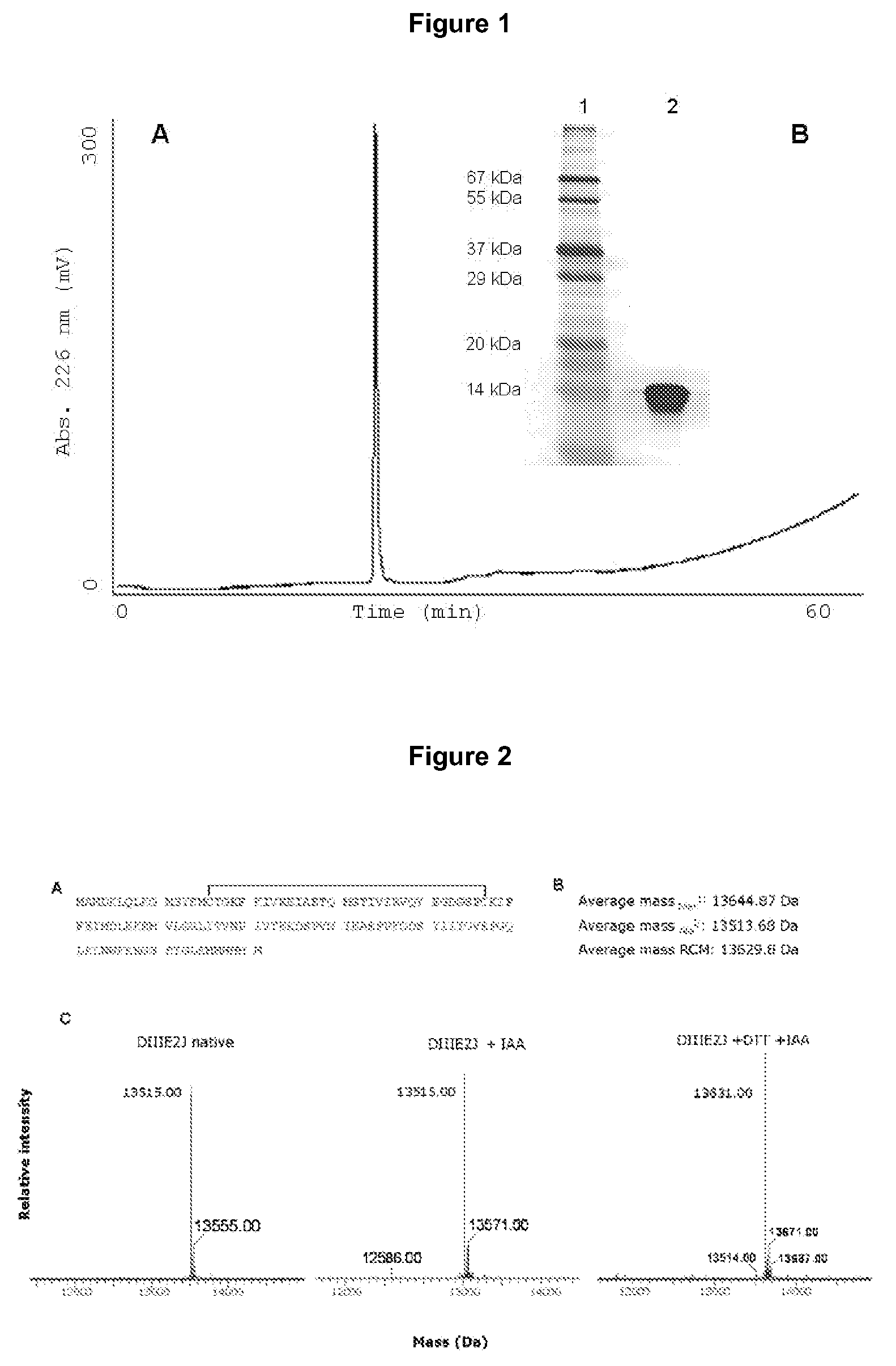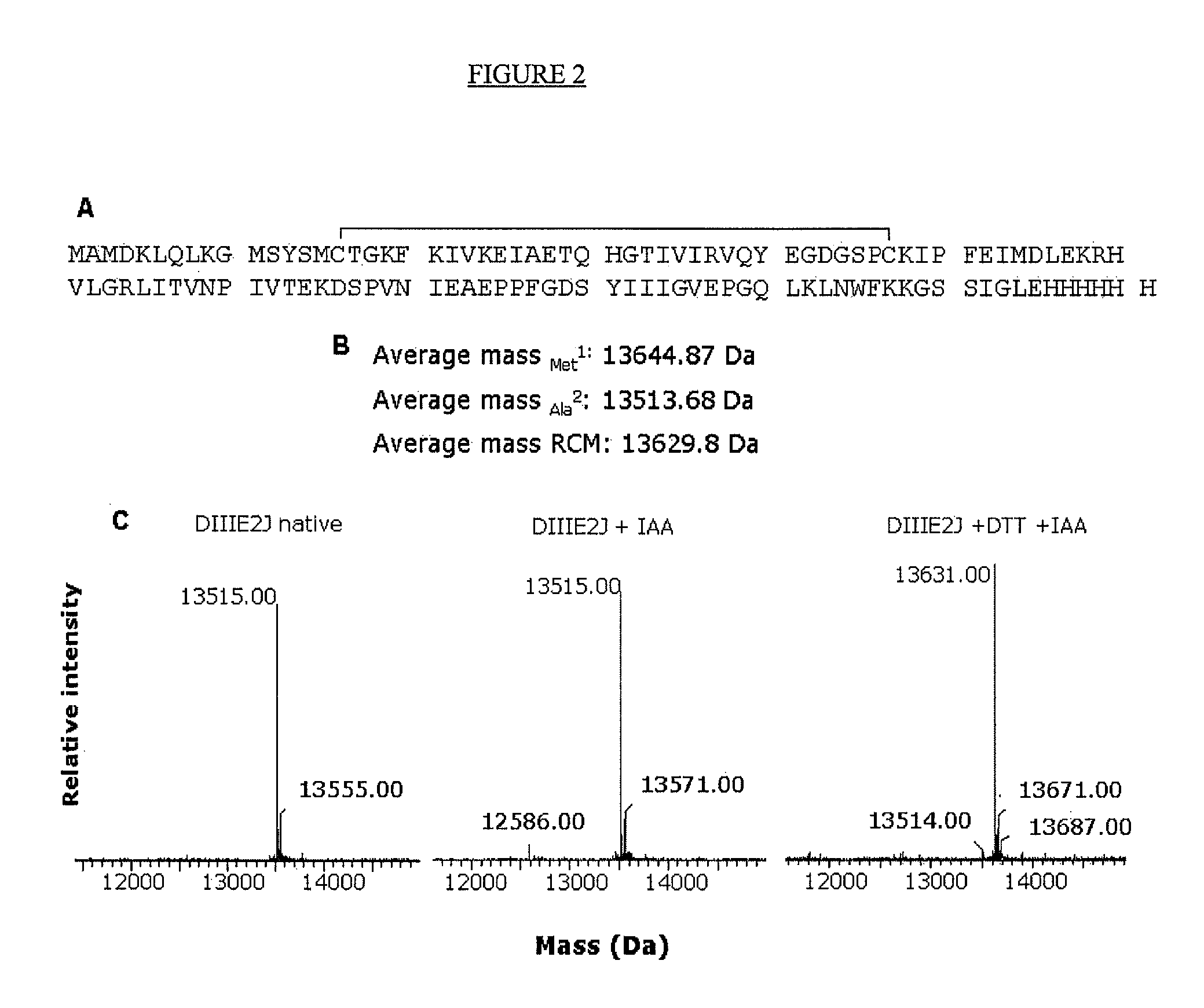Method to block the infection by flaviviruses, molecules and uses
a technology of flavivirus and molecule, applied in the field of methods to block the infection by flavivirus, molecules and, can solve the problems of low-cost vaccin
- Summary
- Abstract
- Description
- Claims
- Application Information
AI Technical Summary
Benefits of technology
Problems solved by technology
Method used
Image
Examples
example 1
Obtention of an Affinity Matrix for the Isolation of Proteins that Bind DIII from DV
[0097]With the aim of preparing an affinity matrix with DIII as a ligand for the isolation of human plasma proteins as potential receptors for DV, the recombinant protein DIIIE2J, comprising residues Met289 to Gly400 (SEQ ID. No. 22) of protein E from DV2, was cloned and expressed in E. coli.
[0098]After IMAC, the obtained preparation has a high purity as assessed by protein electrophoresis, where silver staining only reveals a major band without detectable contaminants (FIG. 1B). In order to discard the possible presence of contaminants which might comigrate with DIIIE2J during electrophoresis, the preparation was analyzed by reversed-phase chromatography (rp-HPLC). An aliquot of 80 μg of DIIIE2J was loaded into a C4 reversed phase 4.6×250 mm column (J. T. Baker, USA). The obtained chromatogram (FIG. 1A) has only a single peak, confirming the high degree of homogeneity of the preparation.
[0099]DIII ...
example 2
Human A2M Interacts Directly with DIII from Protein E of DV2.
[0103]The presence of soluble fragments from cellular receptors in human plasma is widely known. On the other hand, it is also known that the addition of serum to culture media has a marked influence on the efficiency of infection of cultured cells by DV (Nash D R, Halstead S B, Stenhouse A C, McCue C. (1971) Nonspecific Factors in Monkey Tissues and Serum Causing Inhibition of Plaque Formation and Hemagglutination by Dengue Viruses. Infect Immun. 3:193-199). Therefore, it was decided to try to isolate proteins with affinity for DIII of protein E from human plasma, with the aim of screening for potential cellular receptors of DV. Plasma samples, obtained from healthy donors 30 to 40 years old with no detectable antibodies to the virus, were inactivated by incubation at 56° C. for 1 hour, and the precipitated proteins were removed from the solution by centrifugation (5000×g, 10 min.). The supernatant was stored at −80° C. u...
example 3
Determination of the Affinity Constants for the Interaction Between DIIIE2J and A2M by Biacore
[0111]In order to estimate the strength of the interaction between DIIIE2J and human A2M, 1600 RU of DIIIE2J were covalently immobilized on a CM5 chip (channel 1, FIG. 6A) (Biacore, Sweden), following the procedure described in the Materials and Methods section.
[0112]During preliminary experiments (FIGS. 6B and C) it was possible to confirm the presence on the surface of the chip of immobilized protein exposing regions of its surface that are also exposed in the context of the viral particle. This confirmation was achieved by measuring the specific interaction of the immobilized molecules with antibody preparations obtained by immunization with DV. Specifically, the binding by the 3H5 monoclonal antibody (FIG. 6C) evidences the correct exposure and formation of a topographical epitope that depends on the presence of the disulphide bridge between the two cysteine residues of DIII.
[0113]By lo...
PUM
| Property | Measurement | Unit |
|---|---|---|
| molecular mass | aaaaa | aaaaa |
| pH | aaaaa | aaaaa |
| pH | aaaaa | aaaaa |
Abstract
Description
Claims
Application Information
 Login to View More
Login to View More - R&D
- Intellectual Property
- Life Sciences
- Materials
- Tech Scout
- Unparalleled Data Quality
- Higher Quality Content
- 60% Fewer Hallucinations
Browse by: Latest US Patents, China's latest patents, Technical Efficacy Thesaurus, Application Domain, Technology Topic, Popular Technical Reports.
© 2025 PatSnap. All rights reserved.Legal|Privacy policy|Modern Slavery Act Transparency Statement|Sitemap|About US| Contact US: help@patsnap.com



